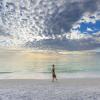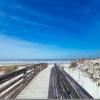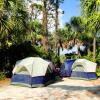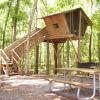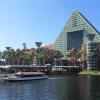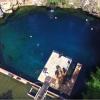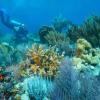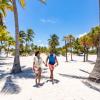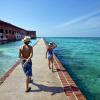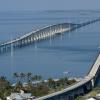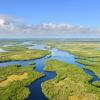Best Florida Beaches for Shelling, Beachcombing
There’s more to the beach than surf and sand. Shells, colored glass, sea beans, eggs and all sorts of natural treasures await your discovery on Florida’s beaches.
By Lauren Tjaden
Beachcombing has been a natural part of my life since my first trip to the beach as a toddler. A little plastic bucket and spade for digging up treasure was all I needed to discover everything the beach had to offer.
The joy felt by a beachcomber, whether child or grown-up, upon finding an unfamiliar or much sought- after object cast upon the beach by the surging surf, is surely akin to that felt by a birder upon adding a new species to his life-list of birds observed.
Beachcombers come in all stripes; some are strictly interested in shells, others may be searching for sea-glass or fossils; still others scour the wrack for sea-beans, or even man-made objects from far-off lands.
Wrack? Sea beans? Those may be unfamiliar terms to you, so let me introduce you to the world of shelling and beachcombing in Florida.
Beachcombing: What is it?
Beachcombing is the practice of meandering along the seashore and picking up whatever catches one's eye.
In years gone by, beachcombing was often practiced by those who were down on their luck or otherwise had scant means and were looking for items to use or sell. Myrtle Scharrer, in her book Yesteryear I Lived in Paradise, wrote about her beachcombing experiences growing up on Caladesi Island in the early 1900s: “If there had been a winter blow, the beach would be newly covered with colorful shells of all kinds. Sometimes there was real treasure to be found . . . a rare junonia, for which . . . a shell dealer would pay ten dollars.” And “sometimes timber washed in—things that could be used for dock repairs and other uses.” Myrtle saw these things as “gifts from the sea.”
The main focus of the beachcomber is the area from just above the high tide line, usually marked by a row of seaweed and debris, down to the water's edge. That line of debris left by the tide is called “wrack.” The wrack can be a thinly scattered line of seaweed, sticks and shells, or it can be a foot-deep mix of seaweed, shells, sponges, fans, sea pork, jellyfish and other marine life as well as boat parts and other cast-offs from passing ships.
Whatever it contains, it is fertile ground for the beachcomber. Let’s have a look at some of the common things a beachcomber might find at Florida's beaches.
Seaweed or Algae
Sea algae and grasses are often referred to as seaweed. Some drift with the currents and others live attached to rocks or other hard surfaces, or have roots in the sandy bottom. At some point, many of them end up on the beach in the sea wrack where they dry up under the scorching sun and return to the earth.
Pick through the wrack and see how many different kinds of algae and grasses you can find. They come in all colors: shades of green, brown, red, pink, purple and even white. Many tiny creatures live and hide in the wrack and are eaten by birds and crabs.
One of the most common types of algae found on the beach is called sargassum weed. It is usually easy to identify because it has hundreds of tiny round air bladders that look like berries. This weed is named after the Sargassum Sea, off the Florida Atlantic coast, where thick mats of sargassum float in its great expanse.
Another type of algae looks almost exactly like lettuce. It's called—you guessed it—sea lettuce. Turtle grass, another seaweed frequently found on the beach, has wide, flat green leaves that sometimes have tiny barnacles growing on them.
Sea Beans and Glass
Sea beans, also called “drift seeds” are seeds or fruits, many from tropical rain forests, that have found their way into the sea and have washed up on the beach, often after drifting at sea for many years and traveling thousands of miles. Beachcombers who search the beaches for sea beans often refer to themselves as “drifters.”
Sea beans are special because they have hard shells that resist the penetration of salt water and they contain air, which allows them to float. Some are able to take root in their new environment.
Because there are so many different kinds of seed, fruits and other plant parts that wash up on the beach, identifying them can be a challenge. One of the most easily recognized sea bean is the coconut. Others have names like hamburger bean, sea purse, starnut palm, monkey pistol and nickernuts. In the hands of an artist, sea beans can be polished using a special process and made into beautiful jewelry.
Sea glass is also highly prized by artisans for making jewelry. Shards of glass from broken bottles that have been abraded by sand and seawater for many years take on a unique appearance and are completely smooth. Next time you are beachcombing in Florida, look for smooth pieces of glass down by the water's edge. They are colorful and easy to see.
Sponges, Whips, Sea Pork and Squirts
One of the more familiar items you may find on the beach is a sponge. Natural, living sponges are frequently seen on the beach or in the wrack. They come in all shapes, colors, and sizes, and have names like sheepswool sponge, redbeard sponge, and golfball sponge.
A sponge is actually composed of the skeletons of many tiny marine animals. Don't expect to take a found sponge back to your hotel room for bathing though. They have to be properly cleaned and dried before they can be used. Your nose will confirm that!
Sea whips and sea feathers are actually soft corals that have thin, somewhat fragile branches. They attach themselves to the sea floor and wave gracefully in the current. When storms or other events dislodge them, they end up on the beach. I love to find the deep purple-colored sea whips.
Sea pork is a kind of tunicate, named because it resembles salted pork, more or less. It comes in all colors and is unmistakable when found on the beach. In their adult form (which is the way we find them), tunicates are simple marine animals that essentially take water in, filter it and discharge it.
Sea squirts are also a common tunicate found on the beach. Most are brown and fist-sized or smaller. When squeezed, they shoot out a thin stream of water, like a squirt-gun. Kids will have fun with that discovery!
Shells
Everyone's favorite, sea shells are by far the most popular find for the beachcomber. Each beach has its own selection of shells.
No two beaches are the same, nor does any one beach have the same selection of shells from day to day. One day might bring a beach full of pen shells. A visit to the same beach a week later might reveal a nice selection of cockleshells and sunray Venus clams.
Experienced beachcombers know to look for shells at low tide and after storms or unusually strong tides. All beaches have shells, but some of the best beaches for shells in Florida are located on the Gulf in southwest Florida.
Sanibel Island is the most famous, and deservedly so. Its shallow waters and beaches are so favored by shellers that their bent-over, shell-hunting body position has been dubbed the “Sanibel stoop.” And no visit to Sanibel is complete without a visit to the Bailey-Matthews Shell Museum.
The hardest-to-find shells, and those in the best condition, are considered the most valuable to collectors who often look for live shells, since they are in the best condition. A live shell is one that still has the living animal inside, be it clam or conch. Many beaches do not allow the taking of live shells, including sand dollars, so be sure to ask.
Some of my favorite beaches for shelling in southwest Florida include:
- Marco Island
- Sanibel / Captiva
- Bonita Beach
- Anna Maria Island
- Caladesi and Honeymoon Islands
Shelling must be one of the least expensive hobbies available. All you really need is a bag or bucket to put the shells in—a separate bag for the more fragile shells is helpful—and, unless you are an expert, a good shell identification guide is a must.
Before you get started on your own beach treasure hunt, I'd like to recommend to you some of my favorite beachcombing resources. After all, to identify everything you find you'll at least need a good field guide. Here are my recommendations:
- Florida's Living Beaches, A Guide for the Curious Beachcomber, by Blair and Dawn Witherington, is a beautiful, full-color book that covers everything you might encounter at the beach, from shells to birds, and from seaweed to man-made flotsam and jetsam. If you only buy one book for beachcombing, this is the one to get.
- The Nature of Florida's Beaches, Including Sea Beans, Laughing Gulls and Mermaids' Purses, written and illustrated by the late Cathie Katz. A more charming book about Florida's beach life has never been written. Easy to read, fascinating and completely practical for the beachcomber. After reading this book you will never look at beach wrack the same way again. In fact, reading any of Cathie Katz's books will give you a new view of the natural world.
